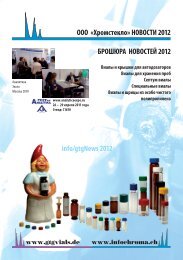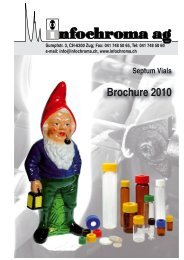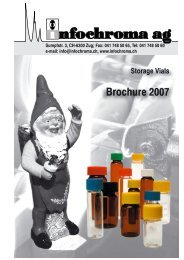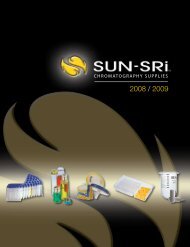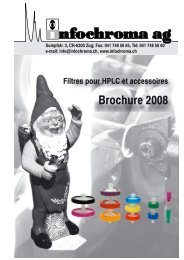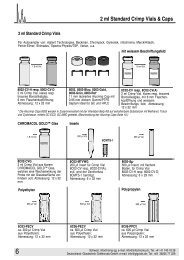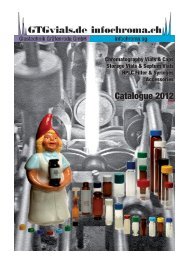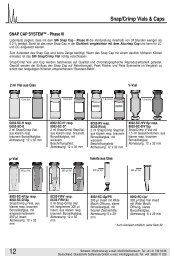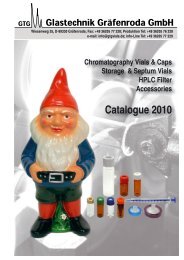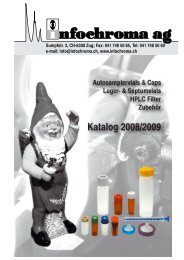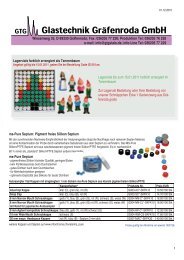Valco Fittings - infochroma ag
Valco Fittings - infochroma ag
Valco Fittings - infochroma ag
Create successful ePaper yourself
Turn your PDF publications into a flip-book with our unique Google optimized e-Paper software.
GENERAL REFERENCE<br />
About Rotor Materials<br />
A variety of polymeric composites have been<br />
developed to meet a variety of customer<br />
requirements for rotors, since no single material<br />
will perform satisfactorily in all situations. This brief<br />
summary of each polymer’s particular features and<br />
potential drawbacks is provided to allow the user to<br />
make a more informed valve selection. Consult our<br />
technical specialists for any additional questions.<br />
VICI polymer composites are proprietary formulations:<br />
only the generic compound class can be discussed.<br />
The specifications in the following discussions are<br />
for two position valves. Multiposition selectors<br />
generally have lower pressure and temperature<br />
limits due to the more complex seal design. Actual<br />
specifications for each valve series are shown<br />
on the appropriate p<strong>ag</strong>es throughout the valve<br />
sections of the catalog. If a valve is to be used at<br />
a pressure higher than the given standard, please<br />
contact the factory for ordering information.<br />
<strong>Valco</strong>n E<br />
A polyaryletherketone/PTFE composite, the<br />
E material receives wide GC use in what had<br />
previously been a problematic gap between the<br />
optimum temperature ranges of P and T, and<br />
in HPLC applications where the temperature<br />
requirement is higher than what can be handled<br />
by the H material and where a lower pressure<br />
limit can be tolerated. (Standard specs are 400<br />
psi at 225°C, but higher pressure ratings are<br />
possible at reduced temperatures.) However, this<br />
polymer cannot be used in prolonged contact<br />
with high concentrations of sulfuric and nitric<br />
acids, DMSO, THF, or liquid methylene chloride.<br />
<strong>Valco</strong>n E2<br />
A proprietary reinforced TFE composite, <strong>Valco</strong>n E2<br />
works well at lower pressures and is suitable for<br />
temperatures up to 75°C. This material is resistant<br />
to most chemicals but should not be used in<br />
prolonged contact with high concentrations of<br />
sulfuric and nitric acids, DMSO, or liquid methylene<br />
chloride.<br />
<strong>Valco</strong>n E3<br />
This designation indicates a proprietary polyimide<br />
blend with chemical properties similar to <strong>Valco</strong>n T,<br />
but with higher compressive strength.<br />
<strong>Valco</strong>n H<br />
This composite, a carbon fiber reinforced, PTFElubricated<br />
inert engineering polymer, has long been<br />
the standard for typical HPLC applications in which<br />
pressures are around 5000 psi and temperatures<br />
are not more than 75°C. It is not unusual for these<br />
valves to be ordered for use at 7000 psi, and less<br />
frequently for use at 10,000 psi. However, at that<br />
point the lifetime may be shortened by as much as<br />
50%.<br />
<strong>Valco</strong>n H is the rotor material used in the W and UW<br />
series, where no rotor material letter is added (as:<br />
C10W or AC6UW).<br />
<strong>Valco</strong>n M<br />
This material, basically a hydrocarbon in structure,<br />
is the most impermeable to light gases of all the<br />
rotor materials currently available, with wide<br />
acceptance in low-temperature (50°C maximum)<br />
trace gas applications. Avoid use with aromatic<br />
hydrocarbons.<br />
<strong>Valco</strong>n P<br />
This composite, the majority of which is PTFE<br />
and carbon, was the standard choice for most GC<br />
applications before the development of <strong>Valco</strong>n E.<br />
(Standard specs are 400 psi at 175°C.) Routinely<br />
used at 1000 psi, 75°C, it can also be used at<br />
temperatures approaching 200°C with decreased<br />
sealing tension; however, at that point <strong>Valco</strong>n E is<br />
probably a better choice from a lifetime standpoint.<br />
<strong>Valco</strong>n E can replace P in most applications.<br />
<strong>Valco</strong>n R<br />
While rarely used today, <strong>Valco</strong>n R (a PTFE<br />
composite) still finds use in low temperature/<br />
pressure situations which require its nearly<br />
universal chemical inertness. Of the chemicals<br />
encountered in commercial practice, only molten<br />
sodium and fluorine at elevated temperatures<br />
and pressures produce any detrimental effects.<br />
Its most severe limitation is that it cannot go over<br />
75°C, even at only 400 psi.<br />
<strong>Valco</strong>n T<br />
This polyimide/PTFE/carbon composite has been<br />
used successfully for many years and still cannot be<br />
surpassed when applications demand operating<br />
temperatures in the 250°C – 350°C range. (Standard<br />
specs for most series are 300 psi at 330°C.) However,<br />
at temperatures below 150°C there is a tendency<br />
for the seal material to stick to the valve body,<br />
making the valve difficult to turn and causing the<br />
rotor to crack in extreme cases. Literature provided<br />
at the time of purchase contains instructions for<br />
reconditioning the material if this condition should<br />
arise. The T material is susceptible to attack from<br />
steam, ammonia, hydrazines (anhydrous liquids<br />
or vapor), primary and secondary amines, and<br />
solutions having a pH of 10 or more. Chemical<br />
re<strong>ag</strong>ents which act as powerful oxidizing <strong>ag</strong>ents<br />
(nitric acid, nitrogen tetroxide, etc.) must also be<br />
avoided. <strong>Valco</strong>n T can be used in “hot” GPC/SEC<br />
applications with O-dichlorobenzene as a solvent.<br />
<strong>Valco</strong>n TF<br />
This is the series designation for a valve with a<br />
virgin PTFE seal. Its mechanical characteristics<br />
are poor compared to the other choices, but<br />
occasionally its use is dictated by the presence of<br />
oxidizing <strong>ag</strong>ents too strong even for the R material.<br />
www.vici.com | <strong>Valco</strong> Instruments Co. Inc. Sales: 800–367–8424 Fax: 713–688–8106 | 257



